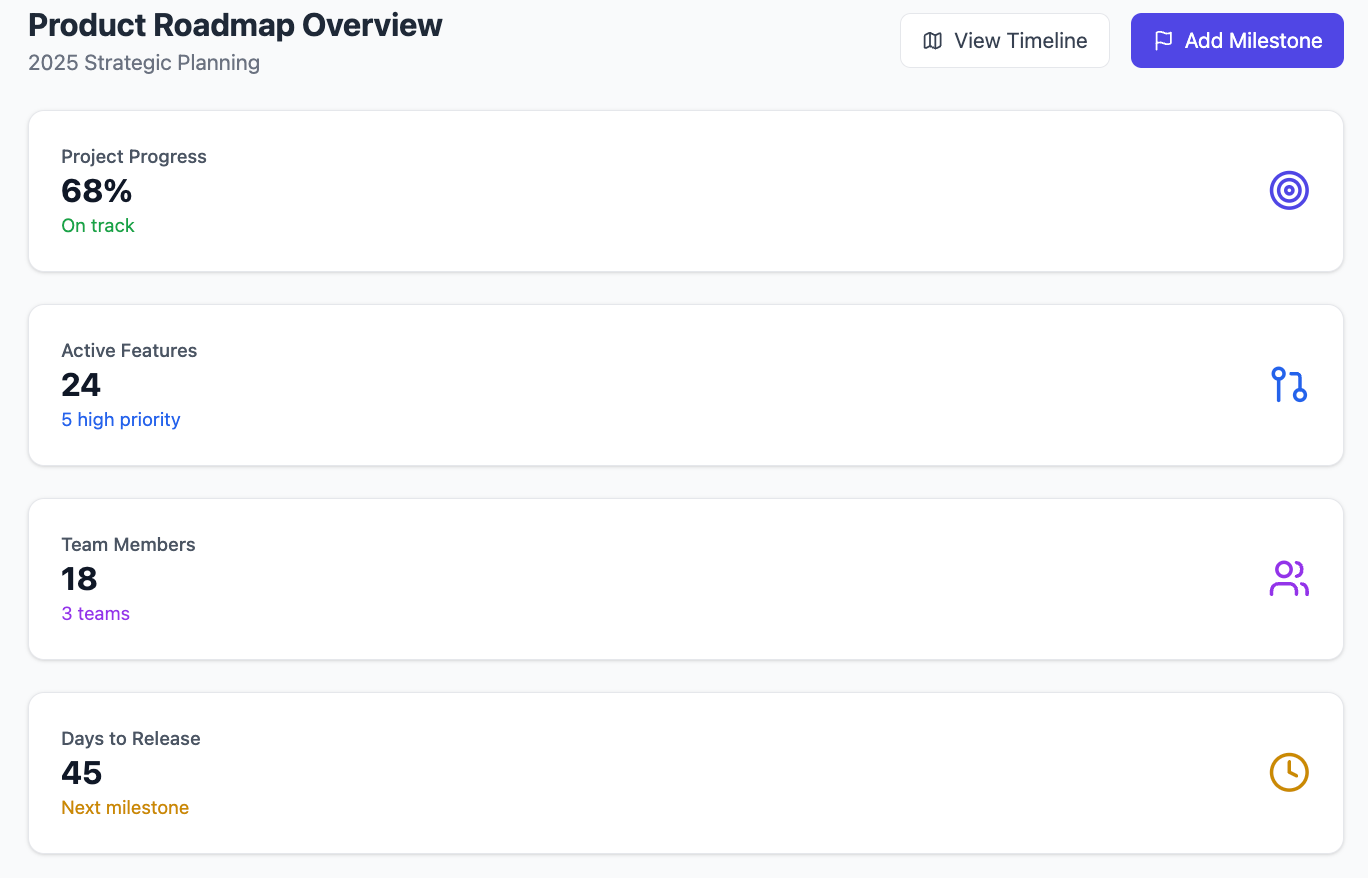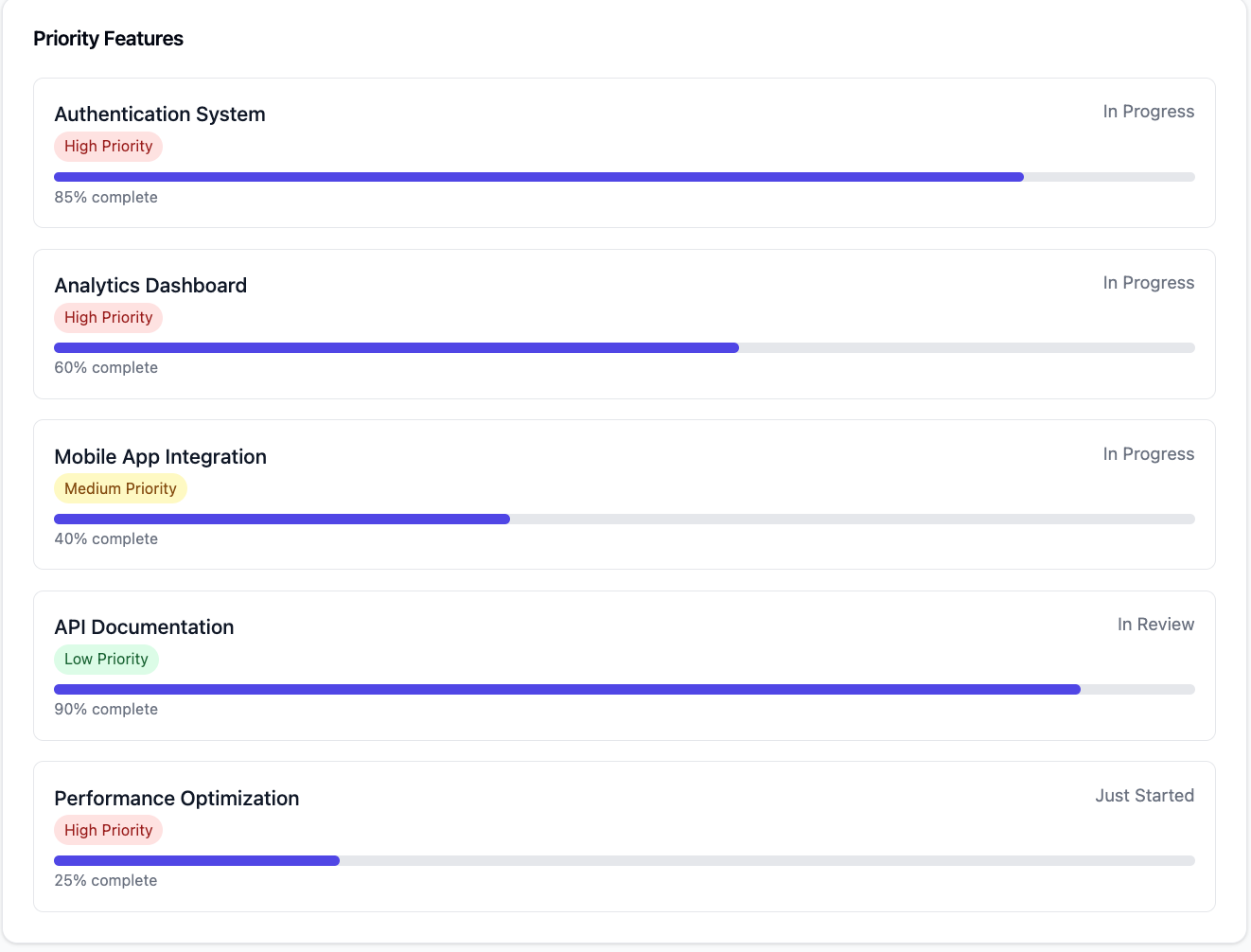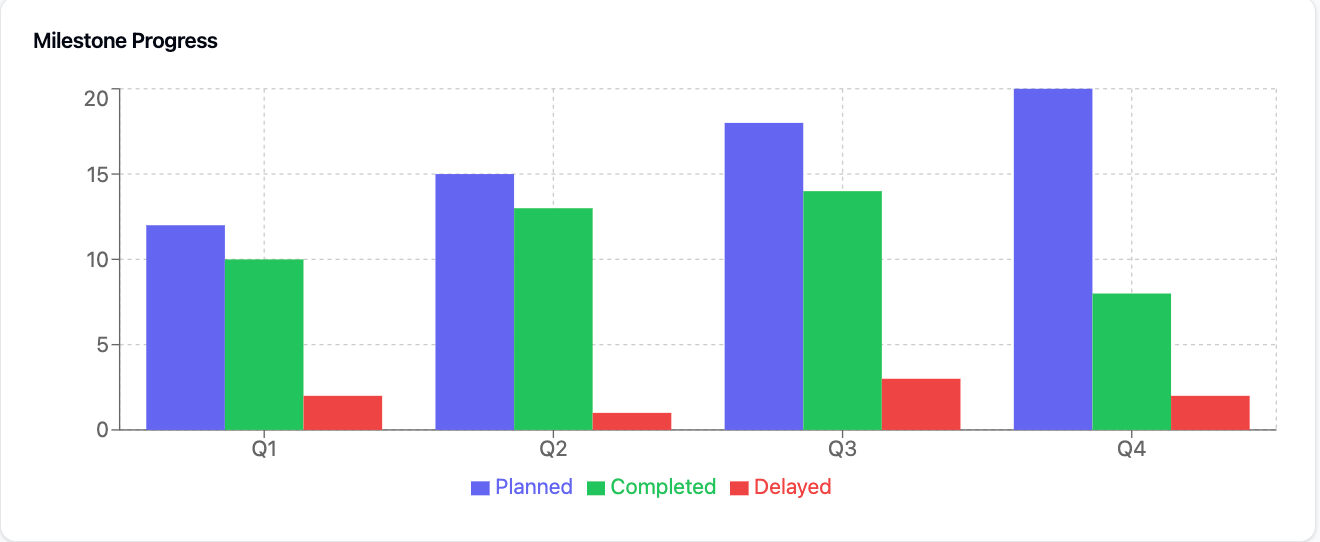How to Build a Product Roadmap Tool with Lovable AI for Success
How to Build a Product Roadmap Tool with Lovable AI: Building Better Roadmaps
In today’s fast paced product development world, having a good roadmap is key to success. Lovable AI is a game changer for product teams looking to create a product roadmap efficiently and effectively. By combining AI with a browser based development environment, Lovable AI is making it possible for teams to build roadmap solutions faster than ever before, emphasizing the importance of creating product roadmaps as a collaborative effort involving various stakeholders.
What is a Product Roadmap?
A product roadmap is a strategic document that outlines the vision, goals, and direction of a product over a specific time period. It serves as a comprehensive guide that communicates the product’s goals, features, and timeline to stakeholders. Essentially, a product roadmap is a visual representation of your product strategy, designed to communicate your product plans to stakeholders, including customers, executives, and team members. By providing a clear and structured overview, a product roadmap helps ensure that everyone involved understands the product’s direction and objectives.
The Importance of Product Roadmaps
Product roadmaps are vital because they provide a clear and concise overview of your product strategy and plans. They help communicate your product vision and goals to stakeholders, including customers, executives, and team members through cross-functional collaboration. Involving key stakeholders in the process ensures that the roadmap aligns with business objectives and prioritizes customer needs. By aligning the team and stakeholders around a common goal, a product roadmap ensures that efforts are prioritized effectively. It also helps to keep everyone on the same page regarding the product’s direction, reducing misunderstandings and ensuring a unified approach to product development.

AI Powered Product Roadmap
Traditional roadmap development takes weeks of planning, coding and iteration. Lovable AI flips this on its head with an AI powered approach. What sets this apart is it can handle complex tasks and automate setup that would normally require technical expertise.
Lovable AI leverages advanced product roadmap software to streamline the entire development process.
The browser based development environment removes the barriers to entry. Teams no longer have to wrestle with local development environments or complex configuration requirements. They can focus on defining and refining their roadmap tools with AI help throughout the entire development process.

Key Components of a Product Roadmap
The key components of a product roadmap include:
-
Product Vision: A clear and concise statement of the product’s purpose and goals. This vision guides the overall direction and strategy of the product.
-
Product Goals: Specific, measurable, achievable, relevant, and time-bound (SMART) objectives that the product aims to achieve. These goals provide a framework for measuring success.
-
Features: The products or services to be built, including their descriptions, priorities, and timelines. This component outlines what will be developed and when. Translating features into user stories helps articulate the benefits from the customer’s perspective and provides essential context for engineering teams to develop effective solutions.
-
Release Plan: A detailed timeline that specifies when and how different features and updates will be delivered to customers. This plan ensures that releases are well-coordinated and timely.
-
Prioritization: The process of determining the importance and order in which different product features should be developed and released. Prioritization helps focus resources on the most critical aspects of the product.
-
Resource Allocation: The assignment of resources, such as personnel, budget, and technology, to support the development and delivery of the product. Effective resource allocation ensures that the necessary support is available for each phase of development.
-
Timeline: A visual representation of the product’s development and delivery timeline, including key milestones and deadlines. This timeline helps track progress and ensures that the project stays on schedule.
By including these key components, a product roadmap provides a comprehensive and actionable plan for the development and delivery of a product, ensuring that everyone involved is aligned and working towards the same goals.

Creating a Product Roadmap
Creating a product roadmap is a crucial step in product development that helps align teams, stakeholders, and customers around a shared vision. A well-crafted product roadmap ensures that everyone is on the same page, working towards common goals, and prioritizing efforts effectively.
Define Your Product Vision
Defining your product vision is the first step in creating a product roadmap. This involves identifying your product’s purpose, goals, and objectives. Your product vision should be clear, concise, and aligned with your business objectives. It should also be communicated effectively to all stakeholders, including your development team, marketing team, and customers.
To define your product vision, consider the following:
-
What problem does your product solve? Understanding the core issue your product addresses is fundamental to shaping its direction.
-
Who is your target audience? Identifying your primary users helps tailor the product to meet their specific needs.
-
What are your product’s unique selling points? Highlighting what sets your product apart from competitors can guide feature development and marketing strategies.
-
What are your business objectives, and how does your product align with them? Ensuring that your product vision supports your broader business goals is crucial for long-term success.
Gather Customer Feedback
Gathering customer feedback is an essential part of creating a product roadmap. Customer feedback helps you understand your customers’ needs, pain points, and expectations. It also helps you identify areas for improvement and prioritize features and requirements.
To gather customer feedback, consider the following:
-
Conduct surveys and interviews with your customers: Direct interactions provide in-depth insights into user experiences and expectations.
-
Analyze customer reviews and ratings: Online reviews can highlight common issues and areas for enhancement.
-
Use social media to gather feedback and engage with your customers: Social platforms offer a wealth of real-time feedback and opportunities for engagement.
-
Use tools like user testing and A/B testing to gather feedback on your product: These methods provide quantitative data on user preferences and behavior.
Prioritize Features and Requirements
Prioritizing features and requirements is a critical step in creating a product roadmap. This involves identifying the most important features and requirements that align with your product vision and business objectives.
To prioritize features and requirements, consider the following:
-
Use the MoSCoW method to prioritize features and requirements: Categorize features into Must-have, Should-have, Could-have, and Won’t-have.
-
Use the Kano model to identify must-have, should-have, and nice-to-have features: This model helps balance basic needs with performance and excitement features.
-
Use customer feedback to prioritize features and requirements: Direct input from users ensures that the most valued features are prioritized.
-
Use data and analytics to inform your prioritization decisions: Leverage usage data and market trends to make informed decisions.
Organize into Releases
Organizing your product roadmap into releases is the final step in creating a product roadmap. This involves breaking down your product roadmap into manageable chunks, assigning timelines and resources, and prioritizing features and requirements.
To organize your product roadmap into releases, consider the following:
-
Use a project management tool to create a release plan: Tools like Trello or Asana can help visualize and manage the release process.
-
Assign timelines and resources to each release: Ensure that each release is well-planned with clear deadlines and resource allocation.
-
Prioritize features and requirements for each release: Focus on delivering the most critical features first.
-
Use a product roadmap template to visualize your release plan: Templates can provide a structured format for presenting your roadmap.
Product Roadmap Tools and Software
There are many product roadmap tools and software available that can help you create and manage your product roadmap. Some popular options include:
-
ProductPlan: A product roadmap software that helps you create and manage your product roadmap with ease. It offers features like drag-and-drop planning, real-time collaboration, and customizable templates.
-
Roadmunk: A product roadmap tool that helps you create and manage your product roadmap. It provides features like timeline and swimlane views, prioritization frameworks, and integration with other tools.
-
Aha!: A product roadmap software that helps you create and manage your product roadmap. It offers features like goal setting, feature prioritization, and detailed reporting.
-
Trello: A project management tool that can be used to create and manage a product roadmap. It provides a visual board for organizing tasks and features, making it easy to track progress.
-
Asana: A project management tool that can be used to create and manage a product roadmap. It offers features like task assignments, timelines, and project tracking.
When choosing a product roadmap tool or software, consider the following:
-
Ease of use and user experience: The tool should be intuitive and easy to navigate.
-
Features and functionality: Ensure the tool offers the features you need, such as prioritization frameworks, collaboration capabilities, and integration options.
-
Integration with other tools and software: The ability to integrate with your existing tools can streamline your workflow.
-
Scalability and customization: Choose a tool that can grow with your needs and be customized to fit your specific requirements.
-
Cost and pricing: Consider your budget and the pricing plans offered by the tool.
By following these steps and using the right tools and software, you can create a product roadmap that aligns your teams, stakeholders, and customers around a shared vision and helps you achieve your business objectives.
Key Benefits of Product Management
Lovable AI’s goes beyond basic automation, with a full suite of features for roadmap development:
Rapid Prototyping and Development Teams can go from concept to functional prototype faster than ever. Automation of repetitive tasks and AI guided solutions means development time is reduced while quality is maintained.
Intelligent Error Detection One of the most powerful features is the AI powered debugging system. It not only detects issues but also suggests and implements fixes automatically, reducing time spent on troubleshooting and maintaining roadmap tools.
Smart Prioritization The platform has algorithms that help teams prioritize features based on multiple factors – customer feedback, market trends and business objectives. This data driven approach means roadmap decisions are aligned to business goals.
Collaboration Built in collaboration features allow team wide involvement in the roadmap development process. The AI helps resolve conflicts and suggests improvements so teams can work together more effectively.
Examples and Use Cases
Lovable AI in action:
Auto Roadmap Generation Teams can create tools that generate initial product roadmaps based on historical data, market trends and user input. Lovable AI offers a variety of product roadmap tools that generate initial roadmaps based on historical data, market trends, and user input. It also provides product roadmap templates that can be used in platforms like Microsoft Excel, Google Sheets, Canva, and Roadmunk. This saves time during planning and ensures all the key aspects are covered.
Dynamic Visualization Tools The platform allows teams to create visual and intuitive roadmap visualizations. These tools make complex product strategy accessible to everyone from development teams to executive leadership.
Predictive Analysis Dashboards One of the most powerful is the ability to build dashboards that forecast outcomes and identify risks. These predictive capabilities help teams make better decisions about product direction and resource allocation.
Getting Started
Building a product roadmap with Lovable AI follows a guided but flexible process. The roadmap creation process with Lovable AI is guided but flexible, ensuring that all key aspects are covered:
-
Requirements Definition Define your roadmap tool requirements to the AI. The more specific you are the better the AI can help you with solutions that match your needs.
-
Smart Prompt Engineering Learn to talk to the AI with well crafted prompts. This is key to guiding the AI to create the structure and functionality of your tool.
-
Feature Implementation Use Lovable to implement features like visualization tools, prioritization algorithms and collaboration features. The platform handles frontend and backend development.
-
Integration and Testing Connect your roadmap tool to existing project management systems and databases. Test everything in the Lovable environment before going live.
-
Deployment and Iterate Launch your tool fast and iterate based on user feedback.
Roadmap
As product development gets more complex, the role of AI in planning and roadmap creation will become more important. Lovable AI is a big step forward in making advanced roadmap tools available to teams of all sizes and technical abilities.
The democratization of roadmap tool development has several long term implications:
-
Lower barrier to entry for pro-grade roadmap tools
-
More focus on strategy rather than technical implementation
-
Technical capabilities aligned to business objectives
-
More agile and responsive product development process
Get the most out of Lovable AI with User Feedback
To get the most out of Lovable AI teams should integrate the platform with their existing workflows:
-
Connect to current project management tools
-
Set up clear communication channels for team feedback
-
Standardize processes for updating and maintaining roadmaps
-
Create metrics to measure AI-assisted planning
Summary
Lovable AI is a big step forward in how product teams approach roadmap development and management. By combining AI with practical functionality teams can create better roadmaps faster.
Whether you are a product manager looking to streamline your roadmap process or a team leader aiming to enhance collaboration, Lovable AI has the tools you need. A startup looking to create their first formal product planning process or an enterprise team looking to upgrade their roadmap capabilities Lovable AI is a solution for you. As the platform grows it will be even more central to product management and strategy.
